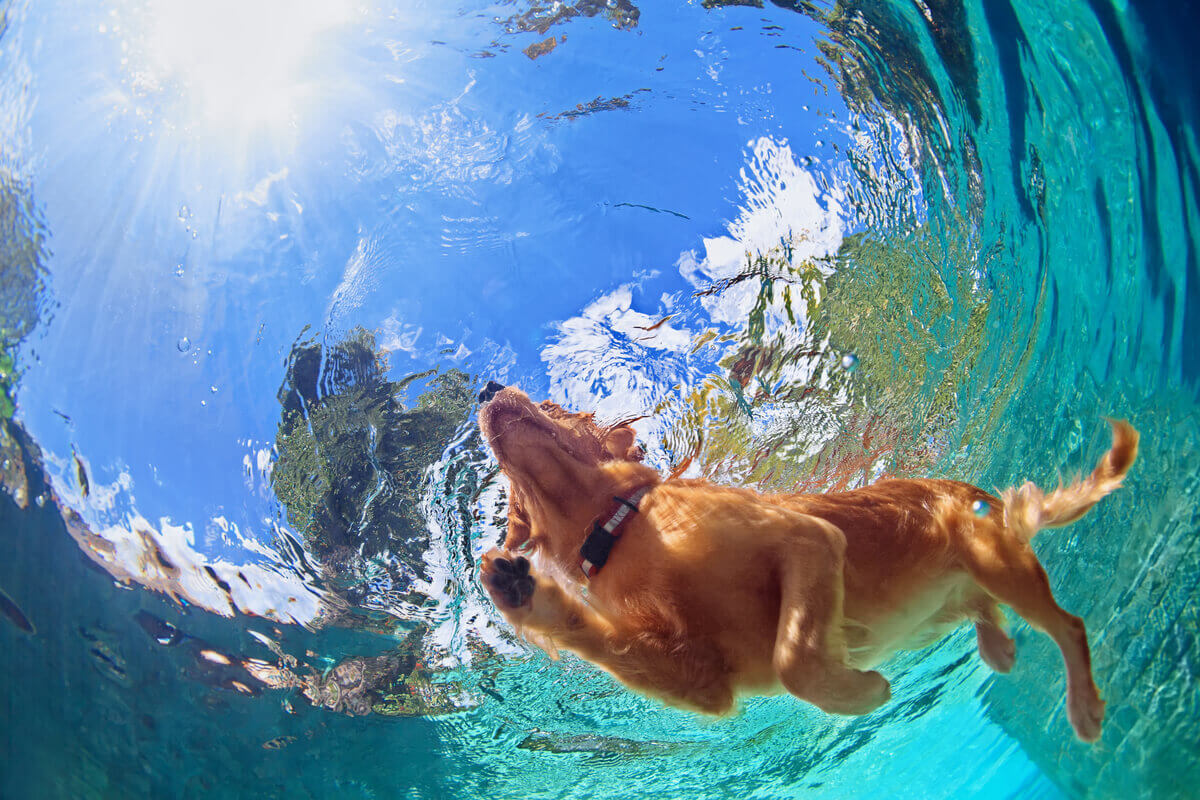5 Tips to Take Into Account if You Want to Swim with Your Dog


Written and verified by biochemistry Luz Eduviges Thomas-Romero
If you love water activities, you’d probably like to swim with your dog. However, your dog may or may not share your tastes. Many dogs love water, while others may be terrified of the simple idea of jumping in it.
As a responsible dog owner, you must be aware of behavior that can put your dog at risk of drowning. Here are five things to keep in mind if you want to swim with your dog.
1. Both breed and physical condition matter
Undoubtedly, some digs breeds were specially developed to do tasks in water. This is the case of the Labrador Retriever or the Nova Scotia Duck Tolling Retriever, which were bred to retrieve downed waterfowl for hunters.
Furthermore, some breeds even have the word water in their name. For example, the Portuguese Water Dog, which was bred to help fishermen, or the Irish Water Spaniel. Naturally, these dogs are excellent swimmers. However, most dogs don’t love swimming.
In general, dogs that are very muscular and those with compromised respiratory function hate being in the water. You probably understand why.
This is the case of brachycephalic breeds, which have short or constricted noses, elongated soft palates, and are prone to laryngeal collapse. English Bulldogs, French Bulldogs, and Pugs belong to this group.
In addition, brachycephalic dogs often have short tails. For this reason, they lack an effective rudder to help direct their body while they’re swimming, which makes them more prone to their rear end sinking.
You should always be careful when you’re trying to get sick, older, or obese dogs into the water, regardless of their breed.

2. A life jacket is the best preventive measure to swim with your dog
No matter the breed, life jackets are always a good idea. However, they’re sometimes essential. For example, when dogs are in open or choppy waters, such as lakes, rivers, and oceans.
They’re also necessary if the dog is very old or if it suffers from limited mobility or some form of disease. Also, overweight dogs and dogs with long torsos and short legs may have a harder time staying afloat. Thus, they should also wear life jackets every time they swim.
It’s important to keep in mind that even dogs that enjoy the water can end up having problems. You must understand that many dog breeds have physiological limitations when it comes to swimming.
Generally, dogs that are learning to swim paddle with their front legs, while their back legs hang down, generally trying to find the bottom. Thus, when a dog wears a life jacket, its back is kept level with the water and the dog begins to paddle on all four legs.
How to choose the best life jacket
The key factors to consider when choosing a life jacket include making sure it’s specifically for your dog’s size and that it provides good buoyancy and visibility. Also, it’s best for it to have reflective badges and bright colors so that you can easily see your dog in the water.
In addition, it’s best for it to have handles that are easy to grab in case you need to rescue your dog.
3. Never leave your dog unsupervised
Your dog should never be allowed to swim unsupervised, especially in water bodies that have currents, such as rivers and oceans. Dogs are less likely to be able to swim to safety to escape a current. For this reason, we recommend keeping your dog on a leash if you’re unsure of their swimming abilities.
4. If you want to swim with your dog, watch for cold water
As a general rule, pet owners should never expose their animals to temperatures they’re uncomfortable with. It’s important to remember that your dog can’t tell you when it’s very cold.
Cold water puts your dog at risk for hypothermia. In such a condition, blood flow is conducted from the surface of the skin and the limbs to vital organs, including the heart, lungs, and brain. Thus, if a dog that’s swimming suffers from hypothermia, its muscles tire, and the risk of drowning increases.
5. Ask your vet about disease prevention
Preventive medications are treatments that can help prevent your dog from catching certain diseases or developing certain conditions. You should also consult your vet if you spend a lot of time outdoors with your dog. You need to be prepared to avoid or treat excessive sun exposure or sea water intake.

It’s important to remember that, while it’s a myth that all dogs are natural swimmers, with a life jacket, patience, and a few dog swimming lessons, each breed should be able to move around in and enjoy the water.
If you love water activities, you’d probably like to swim with your dog. However, your dog may or may not share your tastes. Many dogs love water, while others may be terrified of the simple idea of jumping in it.
As a responsible dog owner, you must be aware of behavior that can put your dog at risk of drowning. Here are five things to keep in mind if you want to swim with your dog.
1. Both breed and physical condition matter
Undoubtedly, some digs breeds were specially developed to do tasks in water. This is the case of the Labrador Retriever or the Nova Scotia Duck Tolling Retriever, which were bred to retrieve downed waterfowl for hunters.
Furthermore, some breeds even have the word water in their name. For example, the Portuguese Water Dog, which was bred to help fishermen, or the Irish Water Spaniel. Naturally, these dogs are excellent swimmers. However, most dogs don’t love swimming.
In general, dogs that are very muscular and those with compromised respiratory function hate being in the water. You probably understand why.
This is the case of brachycephalic breeds, which have short or constricted noses, elongated soft palates, and are prone to laryngeal collapse. English Bulldogs, French Bulldogs, and Pugs belong to this group.
In addition, brachycephalic dogs often have short tails. For this reason, they lack an effective rudder to help direct their body while they’re swimming, which makes them more prone to their rear end sinking.
You should always be careful when you’re trying to get sick, older, or obese dogs into the water, regardless of their breed.

2. A life jacket is the best preventive measure to swim with your dog
No matter the breed, life jackets are always a good idea. However, they’re sometimes essential. For example, when dogs are in open or choppy waters, such as lakes, rivers, and oceans.
They’re also necessary if the dog is very old or if it suffers from limited mobility or some form of disease. Also, overweight dogs and dogs with long torsos and short legs may have a harder time staying afloat. Thus, they should also wear life jackets every time they swim.
It’s important to keep in mind that even dogs that enjoy the water can end up having problems. You must understand that many dog breeds have physiological limitations when it comes to swimming.
Generally, dogs that are learning to swim paddle with their front legs, while their back legs hang down, generally trying to find the bottom. Thus, when a dog wears a life jacket, its back is kept level with the water and the dog begins to paddle on all four legs.
How to choose the best life jacket
The key factors to consider when choosing a life jacket include making sure it’s specifically for your dog’s size and that it provides good buoyancy and visibility. Also, it’s best for it to have reflective badges and bright colors so that you can easily see your dog in the water.
In addition, it’s best for it to have handles that are easy to grab in case you need to rescue your dog.
3. Never leave your dog unsupervised
Your dog should never be allowed to swim unsupervised, especially in water bodies that have currents, such as rivers and oceans. Dogs are less likely to be able to swim to safety to escape a current. For this reason, we recommend keeping your dog on a leash if you’re unsure of their swimming abilities.
4. If you want to swim with your dog, watch for cold water
As a general rule, pet owners should never expose their animals to temperatures they’re uncomfortable with. It’s important to remember that your dog can’t tell you when it’s very cold.
Cold water puts your dog at risk for hypothermia. In such a condition, blood flow is conducted from the surface of the skin and the limbs to vital organs, including the heart, lungs, and brain. Thus, if a dog that’s swimming suffers from hypothermia, its muscles tire, and the risk of drowning increases.
5. Ask your vet about disease prevention
Preventive medications are treatments that can help prevent your dog from catching certain diseases or developing certain conditions. You should also consult your vet if you spend a lot of time outdoors with your dog. You need to be prepared to avoid or treat excessive sun exposure or sea water intake.

It’s important to remember that, while it’s a myth that all dogs are natural swimmers, with a life jacket, patience, and a few dog swimming lessons, each breed should be able to move around in and enjoy the water.
All cited sources were thoroughly reviewed by our team to ensure their quality, reliability, currency, and validity. The bibliography of this article was considered reliable and of academic or scientific accuracy.
- Fish, F. E., DiNenno, N. K., & Trail, J. (2020). The “dog paddle”: Stereotypic swimming gait pattern in different dog breeds. The Anatomical Record.
- Corral, C. (2018). Canine hip dysplasia: rehabilitation. The Veterinary Nurse, 9(6), 304-308.
- Spealman, C. R. (1946). Body cooling of rats, rabbits and dogs following immersion in water, with a few observations on man. American Journal of Physiology-Legacy Content, 146(2), 262-266.
This text is provided for informational purposes only and does not replace consultation with a professional. If in doubt, consult your specialist.








